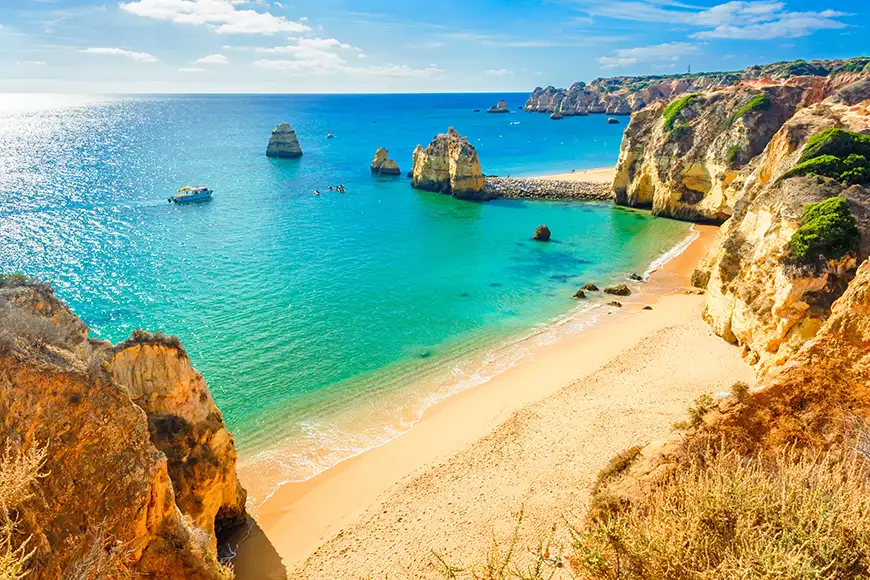While both Portugal and Spain occupy the Iberian Peninsula in southwestern Europe, you may be wondering: Which one should you visit? The best answer is both, of course, but which one to choose depends on what kind of vacation you want to have. Here’s the ultimate rundown on Portugal vs. Spain so you can make the best decision.
Portugal vs. Spain: Language
Portuguese is the official language of Portugal. It’s fairly similar to Spanish, but a word that goes far is obrigado/a for “thank you” (not to be confused with the Spanish gracias).
Spain gets a bit more complicated. While the predominant language is Spanish, and you can hear and see that everywhere, Spain has several semi-autonomous regions that are proud of their heritage and language. I once hopped into a cab in Barcelona and received a grouchy “Catalan or English—no Spanish!” when I tried to give my address. Catalan is spoken widely in places like Barcelona and Valencia, but there’s also Galician in Galicia, and Basque in places like Bilbao.
The good news? English is also widely spoken in both countries, especially in the bigger cities.
Winner: If you speak Spanish, Spain is much easier to navigate. But for simplicity’s sake, Portugal wins this round.
Portugal vs. Spain: Food

Portugal offers some of the best seafood in the Mediterranean, with delicious cod, octopus, prawns, and sardines. It’s less known than other “fine dining” destinations like France, so as a result, incredible multi-course dinners are fairly affordable. This is changing quickly though, with Michelin awarding its first stars to Portuguese restaurants in 2019.
Most restaurants open late—if you can get in at 7:00 p.m., you’re likely in a tourist spot—with dinners stretching into the wee hours of the morning.
One famous dessert you can find in Lisbon is pasteis de nata, an egg custard tart sprinkled with the tiniest bit of powdered sugar. It’s heaven in a bite, and worth the long wait at Pastéis de Belem, around the corner from Jeronimos Monastery.
Spain is globally known for its delicious food, especially its avante-garde fine dining scene made famous by Ferran Adria. But Spanish food is equally delicious in its simplest form: cured meats, cheeses, and olives. You’ll find regional specialties from jamon iberico in Andalusia to paella in Valencia and sea urchin in Costa Brava.
Like Portugal, restaurants are open late. But Spain also enjoys a thriving tapas and pintxos scene—small plates at tiny standing-room-only bars—where you can start your dinner as early as 4:00 p.m.
Winner: This one is close—you won’t go wrong! Portugal is easier for vegetarians and pescetarians, but Spain continues to produce globally renowned restaurants and high-quality food across every region, making it the winner.
[viator_tour destination=”562″ type=”3-mod” tours=”16637P1,25359P1,16168P1″]
Portugal vs. Spain: Wine
In Portugal, head north to Porto, the birthplace of port. You can take a river cruise through the Duoro Valley and sample not just tawny but also ruby, rose, and white port. While you’re there, try vinho verde or “green wine,” which is crisp, acidic, and perfect to pair with seafood, not unlike a sauvignon blanc. Or you can explore the island of Madeira for a wine you’d rather drink than cook with (trust me!).
Spain is known mostly for bold, fruity tempranillos from the Rioja region (similar to a pinot noir or a cabernet sauvignon, depending on how they’re aged), but you’ll also find sparkling cava in Penedes and bright sherries from Jerez. You’ll generally find delicious, surprising options anywhere in the country.
Winner: This one depends on your wine preferences! If you’re a red wine drinker, Spain. If you’re a white wine drinker or into fortified wines, it’s Portugal all the way.
[viator_tour destination=”26879″ type=”3-mod” tours=”7372P30,30924P6,8413P19″]
Portugal vs. Spain: Key Destinations

Start your Portugal trip in the capital city of Lisbon. Covered in tiles and palm trees, it doesn’t feel like the major metropolis it really is. Climb up to the historic Alfama neighborhood, listen to fado fading through the alleyways, ride an iconic yellow tram, or head to Belem to explore monasteries and palaces of old.
Portugal’s charm comes from its laid-back cafe culture. Nearby Sintra offers colorful castles and palaces that inspired Hans Christian Andersen. You’ll find delightful small towns across the country, especially Cascais, Sortelha, and Amarante. Explore medieval Obidos or the Roman ruins in Coimbra.
Portugal’s coastline boasts deep cliffs and gorgeous views. Whether you explore the caverns of Lagos, surf or sea kayak in Albufeira, or hop over to the Azores Islands, you’ll find less crowded beaches than elsewhere in the Mediterranean.
In Spain, you’ll have your pick of big cities between Madrid and Barcelona. Madrid offers cosmopolitan hustle and bustle, world-class museums, and imperial palaces; Barcelona has funky Gaudi architecture, wide-open avenues, and plenty of delicious food.
Head south to Andalusia to slow down and experience Moorish architecture or Granada’s famous Alhambra. Another alternative: Head north to Pamplona to watch the running of the bulls or make the pilgrimage by foot on the Camino del Santiago to the Santiago de Compostela. Try your hand at world-class rock climbing in the Pyrenees, cheer for your favorite team at a soccer match in Barcelona, or watch flamenco dancers twirl and stomp in Seville.
Then, when you’re ready to relax, head to the beach: Spain has nearly 5,000 miles of coastline for you to choose from. Whether you want to hang out in the sleepy fishing town of Cadiz or island hop to nightlife centers like Ibiza or Mallorca, you’ll find perfect cliffside beaches across the country.
Unlike Portugal, Spain struggles with overtourism, which has made it more difficult to visit due to long lines and crowds from cruise ships dropping thousands of visitors overnight. All that really means is you’ll have to adjust your expectations, be willing to pay for a tour to skip the lines, or travel during the shoulder or off-season.
Winner: This one also depends on what you like. For big cities with medieval charm and pristine, relatively empty beaches, Portugal’s the winner. For outdoor enthusiasts and art and architecture lovers, Spain wins this round.
[viator_tour destination=”554″ type=”3-mod”]
Portugal vs. Spain: Cost of Travel
I’ll use two of the most popular destinations in both countries as a proxy for cost—it does vary between high season and low season, and depending on whether you’re in a more popular tourist area. Porto, Portugal, for example, is much cheaper than Lisbon; the little white village of Ronda in Spain is much cheaper than bustling Madrid.
Is Portugal cheaper than Spain? Overall, yes. In Lisbon, you can find a great hotel for around $100 a night depending on the neighborhood, averaging out around $175/night. The average hotel in Barcelona is closer to $200 or $250 depending on the neighborhood.
For restaurants, you’ll pay between 10 and 15 euros for a main course in Lisbon, while Barcelona tends to be between 20 and 30 euros, especially if you’re trying to bag bucket-list dining experiences like a table at Tickets.
Attractions in Portugal also tend to be cheaper—for example, a ticket for the Tile Museum in Lisbon costs 5 euros, while the Prado in Madrid costs 15.
Winner: If you’re on a budget, you won’t beat Portugal’s value. While Spain is definitely still on the cheaper side for most of Europe, Portugal’s the winner.
[viator_tour destination=”538″ type=”3-mod”]
The Bottom Line

Both Portugal and Spain offer a wide variety of exciting attractions and delicious food.
Head to Portugal if you’re a seafood fanatic wary of crowds, or if you’re on a budget. Portugal is an up-and-coming destination that will surprise you.
If you’re really into fine dining, world-class museums, or rock climbing and hiking, Spain is a great choice. It’s the type of destination you can visit again and again and experience something new.
More from SmarterTravel:
- The 13 Best Shoes to Wear in Europe
- Planning a Trip to Europe: Your 10-Step Guide
- 27 Awesome Natural Wonders in Europe
[viator_tour destination=”566″ type=”3-mod”]
Always in search of adventure, Kayla Voigt hails from Hopkinton, Massachusetts, the start of the Boston Marathon. You can usually find her at the summit of a mountain or digging into a big bowl of pasta. Say hi on Instagram @klvoigt.
We hand-pick everything we recommend and select items through testing and reviews. Some products are sent to us free of charge with no incentive to offer a favorable review. We offer our unbiased opinions and do not accept compensation to review products. All items are in stock and prices are accurate at the time of publication. If you buy something through our links, we may earn a commission.
Related
Top Fares From
Today's Top Travel Deals
Brought to you by ShermansTravel
12-Night Peru Escorted Tour, Incl. Sacred...
Wingbuddy
 vacation
$2198+
vacation
$2198+
Amsterdam to Copenhagen: Luxe, 18-Night Northern...
Regent Seven Seas Cruises
 cruise
$12399+
cruise
$12399+
Ohio: Daily Car Rentals from Cincinnati
85OFF.com
 Car Rental
$19+
Car Rental
$19+




